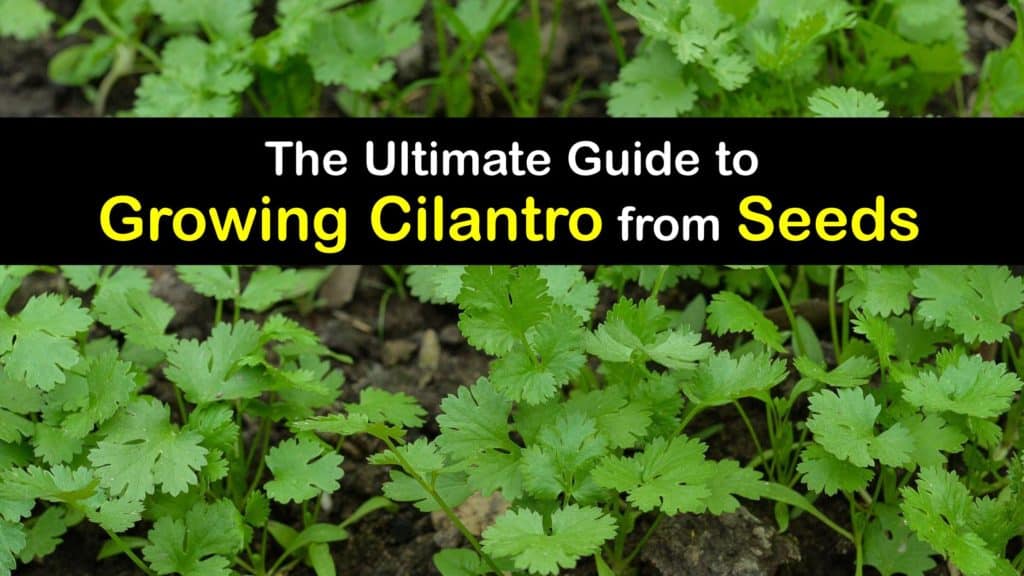If you’ve ever wondered how to grow cilantro from seed, you’re not alone. Cilantro has been a critical ingredient to cook Mexican, Thai, Asian, and Spanish food for generations and may have originated in North Africa or the Middle East. Cilantro seeds have been used medicinally, particularly as a sleep and stomach aid, in addition to various culinary purposes.
The Coriandrum sativum plant’s leaves and stalks are called cilantro in most of North America, while the plant’s dried seeds are coriander. In some world regions, the plant is known as coriander or Chinese parsley, while the seeds are called coriander seeds in others.
Cilantro plants are annuals that grow with a deep taproot and are suitable for most growers to add to their garden. Fresh cilantro tastes delicious to most people, although some individuals find it has a soapy taste.

Everything to Know about Growing Cilantro from Seed
Growing cilantro from seed is a fun and straightforward garden project, and it rewards you with a delicious and versatile fresh herb to use in the kitchen. Learn more about the difference between coriander and cilantro and their benefits for cooking.
Cilantro is a versatile herb and is simple to grow, maintain, and harvest. When looking at cilantro vs parsley, cilantro is unique as it produces two different spices from the same plant. While the cilantro plant is still young, collect the fresh leaves, and once the plant matures, coriander seeds are available for use in many different recipes.
Cooler temperatures are ideal for producing cilantro; start growing cilantro in the early spring and collect the leaves before summer. Cilantro plants immediately stop generating leaves in hot conditions and concentrate their energy on seed production.
Plant a second crop of cilantro near the end of the summer, and the leaves are ready for you to harvest before the end of the cilantro growing season.
Growing cilantro from seed is a great way to have fresh cilantro on hand. By understanding the conditions cilantro requires and where to plant it, how to plant it, how to harvest it, and other tips and tricks, you ensure success when planting cilantro from seed.

Select a Location for Planting Cilantro Seeds
The first step in how to grow cilantro from seed is deciding where in the garden the new plants have the conditions to grow best. Because cilantro is prone to bolting in hot weather, it requires full sun or partial shade in southern zones and thrives in damp, well-drained soil.
When selecting a garden location for your cilantro plants, consider these requirements. Cilantro grows best by spreading seed directly in the garden rather than growing seed heads for transplanting because the plant proliferates quickly and doesn’t require a jumpstart indoors.
Cilantro plants don’t do well with transplanting because they develop a taproot – a large central root from which others grow.
How to Plant Cilantro Seeds in Your Garden
A husk encases each set of two cilantro seeds. The husk is light brown or gray and is firm and spherical. Prepare cilantro seeds before planting to maximize germination.
Gently crush the seed husk attached to the two seeds, and stand the cilantro seeds in water for 1-2 days. Allow the seed to dry entirely after removing them from the water. After you’ve soaked them, it’s time to sow seeds.
Place the seeds in the soil. After seeding the ground, cover the cilantro seeds with a 1/4-inch layer of dirt and add mulch around and not over the seeds to slow weed growth.
Allow the cilantro to grow until it reaches a height of at least 2 inches, and thin the plant to about 3 to 4 inches apart Cilantro does well when grown in crowded settings because the cilantro leaves shade the roots and help protect the plant from bolting in hot weather.
Starting in late spring after the last frost, do successive sowings every 2 to 3 weeks to collect fresh cilantro throughout the season.
Watering Your Cilantro Plants
Cilantro plants develop quickly, so it’s essential to keep the soil moist throughout the first several weeks. Water plants gently to avoid damaging the stems and leaves, and eroding the dirt covering the root system. Use a watering can or a sprayer on the hose, but ensure low water pressure.
Keep your cilantro plants cool and moist by watering them a couple of times a week. Apply a light layer of your chosen mulch to help the soil retain moisture if you haven’t already.
You won’t need to water as frequently once the plants have grown and gone to seed. The plants form a dense canopy to shade and moisten the soil. When seed production begins, stop watering entirely so the seeds dry up to harvest soon if this is your goal.
Best Homemade Cilantro Fertilizer
These plants respond best to a balanced, homemade fertilizer for cilantro like manure tea or other organic matter recipes.
Combine and spray on your cilantro plants when you would typically water them. Fertilize once a week or every other time you water them to provide the boost they require to produce a large amount of tasty foliage. Stop applying fertilizer once the plant flowers appear and the plants begin to set seeds.
How to Grow Cilantro from Seed – Harvesting
How long do cilantro take to grow? Fortunately, not very long at all. When to harvest cilantro for the first time is around 6 to 7 weeks after planting the seed. Harvesting cilantro is a pretty simple process, and cutting cilantro plants approximately one-third of the way down is all it takes. The top third is used for cooking, while the bottom two-thirds produce new leaves.
Make sure you’re using sharp, clean shears or scissors to snip the cilantro stem. Leave a few leaves on the healthy stem to ensure the plant continues to feed itself.
Harvest cilantro once a week. Gather leaves more frequently if the plant is doing well and to keep it from bolting. The way to store cilantro if you cannot immediately cook with the fresh leaves after collecting them is to wrap them in a paper towel and store them in a paper bag in the refrigerator, or freeze them for later use.
Varieties for Growing Cilantro from Seed
Leisure, Slo Bolt, Caribe, California, Jantar, Santos, Terra, Lemon, Delfino, and Moroccan are just a few of the cilantro varieties available.
The Jantar and Santos cultivar are slow bolt types, meaning they are more resistant to bolting and may be an easier choice for many growers in warm areas or a shorter growing season. Other cultivars have better resistance to pests like powdery mildew.
Thankfully, coriander naturally repels aphids, spider mites, and other problem insects like most fragrant herbs. Its pest deterring aroma means it’s a worthy addition to your garden. Excellent companion plants for cilantro include vulnerable species like cabbages, peppers, and tomatoes.
Choose a variety of cilantro compatible with your garden. For example, a cold-hardy cultivar would be best if you live where there is cool weather.
Tips for Planting Cilantro from Seed
Whether cilantro growing indoors or out, the goal is to grow as much edible foliage as possible. To create fuller, bushier cilantro plants when growing cilantro, pinch back immature plants an inch or so. As soon as the top half of the main stem looks to be growing flower heads or seedpods, snip it off.
By removing the flower heads at the flower stalk, the cilantro plants’ energy redirects to leaf production rather than flower head or seed creation.
Even under perfect growing conditions, cilantro is a short-lived herb. Taking the time to prune cilantro regularly assists in avoiding bolting and extending harvest time. No matter how much you prune your cilantro plants, they still bolt eventually.
To ensure a consistent supply throughout the growing season, plant new seeds every six weeks. Cilantro reseeds itself in some USDA zones. Allow the cilantro plant to go to seed if you want it to grow the following year, or plan to gather the cilantro seeds and use them as coriander in a recipe.
Cilantro plants yield a delightful herb as well as a flavorful spice. Cilantro leaves taste best raw as they lose some flavor when dried. For long-term storage, freeze or combine cilantro leaves with butter. Fresh cilantro has a vibrant flavor and is delicious in salsa or as a garnish atop a meal.
Coriander seeds have a slightly spicy flavor, tasting much stronger than the leaves. Easily store the seeds for months to be ground and have them on hand to use in various recipes.
Though cilantro and coriander seeds are becoming increasingly popular in cooking, they aren’t planted as often in home gardens as other popular herbs.
This reluctance by growers could be because many people believe it’s difficult to understand how to plant cilantro seeds, but this is far from the case. Grow cilantro successfully in no time by following these suggestions for growing cilantro from seed in your home garden.

If you loved our article on how to grow cilantro from seed, please share these brilliant tips on how to plant cilantro seeds with your family and friends on Pinterest and Facebook.